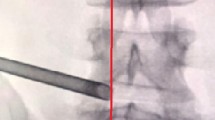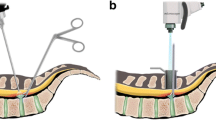Abstract
Conventional lumbar microdiscectomy requires subperiosteal dissection of the muscular and tendineous insertions from the midline structures. This prospective, randomized, single center trial aimed to compare a blunt splitting transmuscular approach to the interlaminar window with the subperiosteal microsurgical technique. Two experienced surgeons performed first time lumbar microdiscectomy on 125 patients. The type of approach and retractor used was randomized and both patients and evaluator were blinded to it. In 59 patients a speculum-counter-retractor was inserted through a subperiosteal (SP) route and in 66 patients an expandable tubular retractor was introduced via a transmuscular (TM) approach. In both groups the mean age was 51 years, the male gender prevalent (61%) and the distribution of the operated levels was similar. The outcome measures were VAS for back and leg pain, ODI and the postoperative analgesic consumption was scored by the WHO 3-class protocol. A postsurgical VAS (0–1) was defined as excellent, VAS (2–4) as satisfactory result. In this study the patients scored from 1 to 3 points daily according to the class of drugs taken. Furthermore, a 1/3 point (class 1), 2/3 point (class 2) and 1 point (class 3) was added for each on-demand drug intake. Recovery from radicular pain was excellent (SP 68%, TM 76%) or satisfactory (SP 23%, TM 21%). Recovery from back pain was excellent (SP 58%, TM 59%) or satisfactory (SP 37%, TM 37%). Postoperative mean improvement ODI was: SP 29% and TM 31%. Postoperative mean analgesic intake: SP 4.8 points, TM 2.6 points (P = 0.03). Lumbar microdiscectomy improves pain and ODI irrespective of the type of approach and retractor used. However, the postsurgical analgesic consumption is significantly less if a tubular retractor is inserted via a transmuscular approach.




Similar content being viewed by others
References
Andrews DW, Lavyne MH (1990) Retrospective analysis of microsurgical and standard lumbar discectomy. Spine 15(4):329–335
Asch HL, Lewis PJ, Moreland DB, Egnatchik JG, Yu YJ, Clabeaux DE, Hyland AH (2002) Prospective multiple outcomes study of outpatient lumbar microdiscectomy: should 75–80% success rates be the norm? J Neurosurg 96(1 Suppl):34–44
Barrios C, Ahmed M, Arrotegui J, Bjornsson A, Gillstrom P (1990) Microsurgery versus standard removal of the herniated lumbar disc. A 3-year-comparison in 150 cases. Acta Orthop Scand 61(5):399–403
Caspar W (1977) A new surgical procedure for the lumbar herniation causing less tissue damage through a microsurgical approach. Adv Neurosurg 4:74–77
Fairbank JC, Couper J, Davies JB, O’Brien JP (1980) The Oswestry low back pain disability questionnaire. Physiotherapy 66(8):271–273
Findlay GF, Hall BI, Musa BS, Oliveira MD, Fear SC (1998) A 10-year follow-up of the outcome of lumbar microdiscectomy. Spine 23(10):1168–1171
Kawaguchi Y, Matsui H, Tsuji H (1996) Back muscle injury after posterior lumbar spine surgery. A histologic and enzymatic analysis. Spine 21(8):941–944
Kim DY, Lee SH, Chung SK, Lee HY (2005) Comparison of multifidus muscle atrophy and trunk extension muscle strength: percutaneous versus open pedicle screw fixation. Spine 30(1):123–129
Lu K, Liang CL, Cho CL, Chen HJ, Hsu HC, Yiin SJ, Chern CL, Chen YC, Lee TC (2002) Oxidative stress and heat shock protein response in human paraspinal muscles during retraction. J Neurosurg 97(1 Suppl):75–81
Maroon JC (2002) Current concepts in minimally invasive discectomy. Neurosurgery 51(5 Suppl):S137–S145
Ogata K, Whiteside LA (1982) Effects of external compression on blood flow to muscle and skin. Clin Orthop Relat Res (168):105–107
Palmer S (2002) Use of a tubular retractor system in microscopic lumbar discectomy: 1-year prospective results in 135 patients. Neurosurg Focus 13(2):E5
Ranjan A, Lath R (2006) Microendoscopic discectomy for prolapsed lumbar intervertebral disc. Neurol India 54(2):190–194
Schick U, Dohnert J, Richter A, Konig A, Vitzthum HE (2002) Microendoscopic lumbar discectomy versus open surgery: an intraoperative EMG study. Eur Spine J 11(1):20–26
Schizas C, Tsiridis E, Saksena J (2005) Microendoscopic discectomy compared with standard microsurgical discectomy for treatment of uncontained or large contained disc herniations. Neurosurgery 57(4 Suppl):357–360; discussion 357–360
Smith M, Foley K (1997) Microendoscopic discectomy. Tech Neurosurg 3:301–307
WHO (1990) Cancer pain relief and palliative care. Report of a WHO Expert Committee. World Health Organ Tech Rep Ser 804:1–75
Williams RW (1978) Microlumbar discectomy: a conservative surgical approach to the virgin herniated lumbar disc. Spine 3(2):175–182
Yasargil MG (1977) Microsurgical operation of herniated lumbar disc. Adv Neurosurg 4:81–88
Author information
Authors and Affiliations
Corresponding author
Rights and permissions
About this article
Cite this article
Brock, M., Kunkel, P. & Papavero, L. Lumbar microdiscectomy: subperiosteal versus transmuscular approach and influence on the early postoperative analgesic consumption. Eur Spine J 17, 518–522 (2008). https://doi.org/10.1007/s00586-008-0604-2
Received:
Revised:
Accepted:
Published:
Issue Date:
DOI: https://doi.org/10.1007/s00586-008-0604-2




